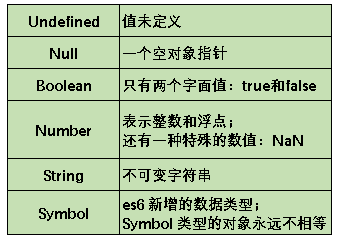今天要分享的问题就是:如何在JS中检查一个变量的类型?
先上结论:
如果判断的是基本数据类型或JavaScript内置对象,使用toString;如果要判断的是自定义类型,请使用instanceof。
在 ECMAScript 规范中,共定义了 7 种数据类型,分为 基本类型 和 引用类型 两大类。
基本类型 也称为简单类型,按值访问。
引用类型 也称为复杂类型,按址访问。
JavaScript内置了一些引用类型,如图所示:
JavaScript的变量是松散类型。虽然这使得提供类型信息的方式更加灵活了,但也容易误用。
下面来分析常见的四种JavaScript类型检查方法:typeof, instanceof, constructor, toString。
typeof
typeof是一个操作符,其右侧跟一个一元表达式,并返回这个表达式的数据类型。
它返回的结果用该类型的字符串(全小写字母)形式表示。返回值有7种取值:number、boolean、symbol、string、undefined、object和function。
typeof 3; // number 有效
typeof true; //boolean 有效
typeof Symbol(); // symbol 有效
typeof ''; // string 有效
typeof undefined; //undefined 有效
typeof null; //object 无效
typeof [] ; //object 无效
typeof new Function(); // function 有效
typeof new Date(); //object 无效
typeof new RegExp(); //object 无效
有些时候,typeof操作符会返回一些令人迷惑但技术上却正确的值:
- 对于基本类型 ,除
null以外,均可以返回正确的结果。 - 对于引用类型 ,除
function以外,一律返回object类型。 - 对于
null,返回object类型。这是一个知名的bug。由于影响范围越来越大,就没有修复了。 - 对于
function函数,返回 function 类型。从技术角度讲,函数在ECMAScript中是对象,不是一种数据类型。然而,函数也确实有一些特殊的属性,因此通过typeof操作符来区分函数和其他对象是有必要的。
由上可以得出:typeof对引用类型 操作的返回值不是我们想要的结果。
instanceof
instanceof是用来判断 A 是否为 B 的实例的。它的表达式为:A instanceof B。
如果 A 是 B 的实例,则返回 true,否则返回 false。 在这里需要特别注意的是:instanceof断规则是某个对象的原型链是否包含某个构造函数的prototype属性。
let arr = [];
arr instanceof Array; // true
arr instanceof Object; // true
看看arr原型链简图:
arr的 __proto__ 直接指向Array.prototype,间接指向 Object.prototype,所以按照 instanceof 的判断规则,[] 就是Array的实例,也是Object的实例。instanceof返回值都是true。
依此类推,RegExp, Object, Function也会形成一条对应的原型链 。
/abc/ instanceof RegExp // true
({}) instanceof Object // true
(function(){}) instanceof Function // true
instanceof是通过原型链来检查类型的,所以适用于任何"object"的类型检查。自定义的类型同样满足。
// 比如直接原型关系
function Fruit(){ }
(new Fruit) instanceof Fruit // true
// 原型链上的间接原型
function Apple(){}
Apple.prototype = new Fruit
(new Apple) instanceof Fruit // true
注意instanceof对基本数据类型 不起作用,因为基本数据类型没有原型链。
3 instanceof Number // false
true instanceof Boolean // false
'abc' instanceof String // false
null instanceof String // always false
undefined instanceof String // always false
但你可以这样:
new Number(3) instanceof Number // true
new Boolean(true) instanceof Boolean // true
new String('abc') instanceof String // true
但这时你已经知道数据类型了,类型检查已经没有意义了。
使用constructor属性
constructor 属性返回一个指向创建了该对象原型的函数引用。需要注意的是,该属性的值是那个函数本身。例如:
function Fruit(){}
var a = new Fruit
a.constructor === Fruit // true
constructor不适合用来判断变量类型。
- 其一,它是一个属性,非常容易被伪造:
var a = new Fruit
a.constructor === Array
a.constructor === Fruit // false
- 其二,
constructor指向的是最初创建当前对象的函数,是原型链最上层的那个方法:
function Apple(){}
Apple.prototype = new Fruit
function BadApple(){}
BadApple.prototype = new Apple
(new BadApple).constructor === Fruit // true
Fruit.constructor === Function // true
与instanceof类似,constructor只能用于检测引用对象,对基本数据类型无能为力。
与instanceof不同的是,在访问基本数据类型的属性时,JavaScript会自动调用其构造函数来生成一个对象。例如:
(3).constructor === Number // true
true.constructor === Boolean // true
'abc'.constructor === String // true
// 相当于
(new Number(3)).constructor === Number
(new Boolean(true)).constructor === Boolean
(new String('abc')).constructor === String
这种将一个值类型转换为对象引用类型的机制在其他语言中也存在,称为装箱。
但在基本数据类型中,null和undefined调用constructor会抛出TypeError异常。
null.constructor // TypeError!
undefined.constructor // TypeError!
因为null是JavaScript原型链的起点,undefined是无效对象,都没有构造函数,也就不存在constructor属性。
instanceof跨窗口问题
我们知道Javascript是运行在宿主环境下的,而每个宿主环境会提供一套ECMA标准的内置对象,以及宿主对象(如window, document),一个新的窗口即是一个新的宿主环境。 不同窗口下的内置对象是不同的实例,拥有不同的内存地址。
而instanceof和constructor都是通过比较两个Function是否相等来进行类型判断的。 此时显然会出问题,例如:
var iframe = document.createElement('iframe');
var iWindow = iframe.contentWindow;
document.body.appendChild(iframe);
iWindow.Array === Array // false
// 相当于
iWindow.Array === window.Array // false
因此iWindow中的数组arr原型链上是没有window.Array的。请看:
iWindow.document.write('<script> var arr = [1, 2]</script>');
iWindow.arr instanceof Array // false
iWindow.arr instanceof iWindow.Array // true
使用toString方法
使用toString方法是最为可靠的类型检测手段,它会将当前对象类型转换为字符串并输出。
toString属性定义在Object.prototype上,因而所有对象都拥有toString方法。但Array, Date等对象会重写从Object.prototype继承来的toString,所以最好用Object.prototype.toString来检测类型。
toString = Object.prototype.toString;
toString.call(new Date); // [object Date]
toString.call(new String);// [object String]
toString.call(Math); // [object Math]
toString.call(3); // [object Number]
toString.call([]); // [object Array]
toString.call({}); // [object Object]
// Since JavaScript 1.8.5
toString.call(undefined); // [object Undefined]
toString.call(null); // [object Null]
采用toString也不是完美的,它无法检测用户自定义类型。因为Object.prototype是不知道用户会创造什么类型的,它只能检测ECMA标准中的那些内置类型。
toString.call(new Fruit) // [object Object]
因为返回值是字符串,也避免了跨窗口问题。当然IE弹窗中还是有Bug,不必管它了。 现在多少人还在用IE?多少人还在用弹窗?
和Object.prototype.toString类似地,Function.prototype.toString也有类似功能,不过它的this只能是Function,其他类型(例如基本数据类型)都会抛出异常。
其他
有时Duck Typing的类型推断方式也非常可行,貌似已经成为了前端的惯例。比如jQuery是这样判断一个Window的:
isWindow: function(obj){
return obj && typeof obj === 'object' && "setInterval" in obj;
}
总结
typeof只能检测基本数据类型,对于null还有Bug;instanceof适用于检测对象,它是基于原型链运作的;constructor指向的是最初创建者,而且容易伪造,不适合做类型判断;toString适用于ECMA内置JavaScript类型(包括基本数据类型和内置对象)的判断;- 引用类型 检查都有跨窗口问题,比如instanceof和constructor。
总之,如果你要判断的是基本数据类型或JavaScript内置对象,使用toString; 如果要判断的是自定义类型,请使用instanceof。
文章来源: 博客园
- 还没有人评论,欢迎说说您的想法!





 客服
客服


